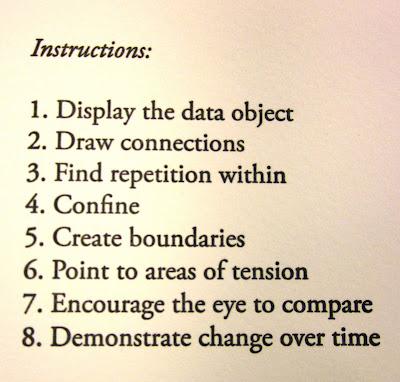





Ahoy! My first book project at The Press! Not only did I discover that I can't get enough of teal and red together, I also discovered how incredibly satisfying it is to print a book. I spent second block of this school year investigating some of the fundamentals of design, particularly digital design techniques. The majority of the block was spent messing around on photoshop and illustrator, trying some of Ellen Lupton's assignments from Thinking with Type. I also dilligently worked in a sketchbook, using a method for developing an idea that I lifted from Nadine Nakanashi of Sonnenzimmer in her artist book called Formal Additive Programs. In Formal Additive Programs, Nadine gives herself 18 Instructions: abstract verbal cues in order to proceed from one drawing to the next. These instructions include "Continue Motion & Move Freely," "Isolate, Observe and Compare" and "Listen to the Rhythm of the Patterns." Her drawings thoughtfully respond to these prompts and the book and ultimately generate a body of images that could be used as jumping off points for other projects. I found that if my initial drawing wasn't that great, it didn't matter because the third or fourth mutation was something completely abstracted from the first. For me, there was a good balance between relinquishing control, following instincts and trusting my internal dialogue.
After a few weeks of doing sets of these exercises every morning, I found a series of these that I liked enough to make into a letterpress book, hence Graphical Objectives came together. I found I was thinking a lot about graphs, maps and diagrams as visually gripping objects for their formal qualities rather than the information they conveyed. I also perused The Visual Display of Quantitative Information by Edward Tufte which discussed the theory and practice of data graphics. Here are some of the examples of my own formal additive programs from my sketchbook:
With a lot of help and patience from Aaron, I began to lay out, print and bind the book. Graphical Objectives was printed on our beloved Vandercook-219 over block break (during which I listened exclusively to Andrew Bird.) Amazingly, there weren't any huge snafus or "OH SHIT!" moments, which I had definitely anticipated. Registration, particularly on the last page was tight, but not too many pages were lost to mistakes. If I could print it again, I would err on the side of more ink and be more careful about the placement of the first page so that the teal wouldn't come through onto the fourth page.
Four months later, I am still incredibly psyched on this book and plan on making more. It was great to mail it to friends and family, and watch them read it. A lot of the recipients read the instructions, gave me a puzzled look, flipped through the book quickly, went back to the instructions and went through again more slowly. It was interesting to be able to compel almost every reader to go through it twice.
Recently, I read an essay by Karl Young, (not to be confused with called Carl Jung) "Notation and the Art of Reading" in which he discusses Aztec, Chinese and Early English ways of reading. He notes that early Chinese readers "in writing or reading poetry...tend to be much more attuned to the interworkings of sound, sight, gesture and idea. The interaction of components emphasizes continuity and versatility; a mind trained to read interwoven pictograms, graphs of gesture, phonograms and ideograms can be expected to feel a continuity between sight, sound, gesture and intellection." (Young, p. 33) This idea relates to the concept I had in mind for how readers might look at my book - written instructions that visually move from one graphic to another continuously, linking sight, intellection and intuition.
Headiness aside, I still can't beat my grandpa's comment over the phone the other day: "I don't know what it means, but I like touching it!"
Karl Joung, "Notation and the Art of Reading," A Book of the Book: Some Thoughts & Projections About the Book & Writing, ed. Steve Clay and Jerome Rothenberg (New York: Granary Books, 2000), 33






























